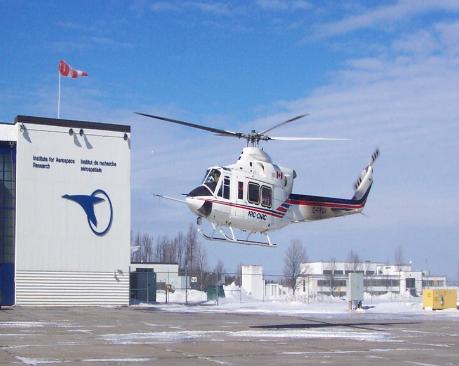Flight tests performed with the Bell 412 ASRA
Summary - Several novel control laws were tested on the Bell 412 Advanced Systems Research Aircraft. A brief description of these tests is given here, including a description of the complete process from the design of a control law to the flight test of this control law.
The process of control law design is done as follows:
- Design on linear aircraft model
- Implementation and analysis on the nonlinear simulation model
- Piloted simulation
- Implementation on the Bell 412 Advanced Systems Research Aircraft
- Flight test
As stated above, the control law design process starts with the design on a linear aircraft model. The linear aircraft models are obtained from our high-fidelity nonlinear simulation model of the Bell 412 ASRA. The control laws are designed using the performance requirements stated in ADS-33, the handling qualities requirements specification for military rotorcraft. The control law is subsequently implemented on the nonlinear simulation model and subjected to piloted simulation. It can take several design iterations before the control law is deemed to be good enough to be tested in-flight. The control law is then coded in C++ and sent to the NRC, where it is implemented in the fly-by-wire system and flight tested. The C++ code used is either our own in-house code or code generated by the MATLAB Real Time Workshop (RTW).

Important milestones in the flight test program
December 2005 - Systems Check and test of multivariable control law
The first flight test was performed with an H-infinity control law providing an ACAH response type in pitch and roll and a RC response type in yaw. The control law proved to be stable and everything was functioning as intended. The main purpose of this test was to see whether we could successfully implement a control law using our in-house developed C++ code. The test also proved that the control law had good performance with a high bandwidth. Important to note is that the predicted bandwidths from simulation and the bandwidths obtained from flight test correlated very closely
June 2006 - Flight test of nonlinear control law and additional testing of multivariable control law
A successful flight test was performed with a low performance nonlinear control law. The goal of the test was to show that the we could design stable and flyable nonlinear control laws. Describing function analysis was found to be a useful tool for stability analysis of nonlinear control laws. Additional testing was also performed with the multivariable control law that was tested in December 2005.
October 2006 - Test of code developed with Real Time Workshop and test of a high performance nonlinear control law
The controllers tested so far were implemented on the aircraft with our in-house developed C++ code. It was the aim in this flight test to show that we can also develop the code with the Matlab Real Time Workshop. This is quite important for the coding of more complex control systems with a lot of different functions, which we aim to develop in the near future. The test was successful and the code developed with RTW functioned as desired. A second goal of the test was to evaluate a high performance nonlinear control law. This system proved to be stable and flyable.